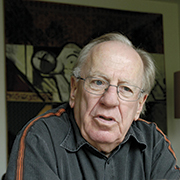Rudolf Kelterborn’s Ensemble-Buch V”, a composition for six instruments, receives its premiere in Zurich. His series of “Books” for differently-scored ensembles explore a multifaceted variety of forms.
[t]akte: Rudolf Kelterborn, your Ensemble-Bücher I, II and IV are works for voice and different instrumental forces, and explore the multitude of relationships between text and music. In your new Ensemble-Buch V you’ve composed a purely instrumental work (as you did previously in Buch III), however, the movements have very eloquent, poetic titles: Chemins, Dark music – Cris du monde, Natura morta 1, Illuminations, Beating and Whispering, Natura morta 2 – Apertura). Is there also a reference here to literary works?
Kelterborn: With my Ensemble-Buch V there is no literary background or other references to extra-musical events. The “eloquent, poetic” movement titles might, however, draw the listener’s imagination in a particular direction, and in the process, illustrative or poetic associations are more than possible – but such personal associations would be, so to speak, “private” and in no way universally binding.
What should the listener expect in the individual movements of Ensemble-Buch V? How do you approach the delightful forces of flute, clarinet, violin, cello, piano and percussion? My Ensemble-Bücher are compositions in which the whole ensemble is only used as one of several scoring formations. In my Ensemble-Buch I for baritone and 13 instruments to poems by Erika Burkart, as well as tutti movements there are, for example, two movements just for baritone and piano, a movement for baritone, violin and cello, a “Nachtstück” for eight instruments, etc. In my most recent purely instrumental Ensemble-Buch V, in five of the six movements all six instruments are used; but within the individual movements different sub-groups are constantly created. The first movement “Chemins”, for example, begins with a duo of piano/percussion, and a longer section for clarinet, cello, piano and percussion follows – tutti scoring is only used in the last section of the movement. Or in the second movement “Dark Music – Cris du monde”, the opening is scored for a darkly-coloured ensemble with bass flute, bass clarinet, cello, piano and percussion, whilst the last part is contested by a quartet (flute, clarinet, violin and cello). “Natura morta 1” (the third movement) is scored for just violin and piano, the last movement “Natura morta 2 – Apertura” for bass clarinet and percussion in the first section, and in the second section then for the whole ensemble.
Your Ensemble-Bücher seem to be like an encyclopaedia of the many and diverse possibilities for the different scorings. Do the “Bücher” also form a cycle within themselves which the titles might suggest?
The Ensemble-Bücher I–V are each independent compositions, they don’t form a cycle. But you could definitely perform three of the works one after another in a concert, for example. I can well imagine that this might produce the effect of a greater whole.
Which formal aspects should be emphasized?
The special approach to the scoring of the ensemble in each Ensemble-Buch, in which the tutti is only one of several different formations, of course essentially determines the forms of the individual movements as well as the whole work. At the same time the use of different types of a family of instruments (for example, flute, piccolo, alto and bass flute) can enrich the formal possibilities.
Interview by Marie Luise Maintz
(from [t]akte 1/2015)



